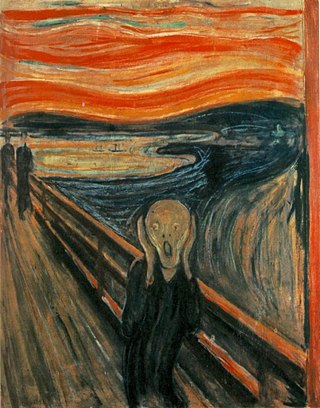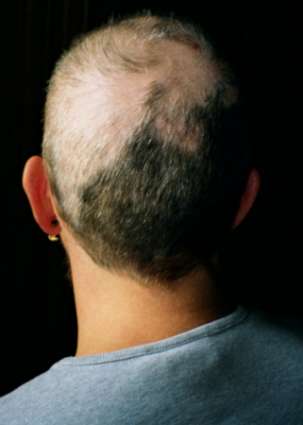Related Research Articles

Cognitive behavioral therapy (CBT) is a psycho-social intervention that aims to reduce symptoms of various mental health conditions, primarily depression and anxiety disorders. Cognitive behavioral therapy is one of the most effective means of treatment for substance abuse and co-occurring mental health disorders. CBT focuses on challenging and changing cognitive distortions and their associated behaviors to improve emotional regulation and develop personal coping strategies that target solving current problems. Though it was originally designed to treat depression, its uses have been expanded to include the treatment of many mental health conditions, including anxiety, substance use disorders, marital problems, ADHD, and eating disorders. CBT includes a number of cognitive or behavioral psychotherapies that treat defined psychopathologies using evidence-based techniques and strategies.

Anxiety disorders are a cluster of mental disorders characterized by significant and uncontrollable feelings of anxiety and fear such that a person's social, occupational, and personal function are significantly impaired. Anxiety may cause physical and cognitive symptoms, such as restlessness, irritability, easy fatiguability, difficulty concentrating, increased heart rate, chest pain, abdominal pain, and a variety of other symptoms that may vary based on the individual.

Trichotillomania (TTM), also known as hair-pulling disorder or compulsive hair pulling, is a mental disorder characterized by a long-term urge that results in the pulling out of one's own hair. A brief positive feeling may occur as hair is removed. Efforts to stop pulling hair typically fail. Hair removal may occur anywhere; however, the head and around the eyes are most common. The hair pulling is to such a degree that it results in distress and hair loss can be seen.

Compulsive hoarding, also known as hoarding disorder or Plyushkin's disorder, is a mental disorder characterised by accumulation of possessions due to excessive acquisition of or difficulty discarding them regardless of their actual value, leading to clinically significant distress or impairment in personal, family, social, educational, occupational, or other important areas of functioning. Excessive acquisition is characterized by repetitive urges or behaviours related to amassing or buying property. Difficulty discarding possessions is characterized by a perceived need to save items and distress associated with discarding them. Accumulation of possessions results in living spaces becoming cluttered to the point that their use or safety is compromised. It is recognised by the eleventh revision of the International Classification of Diseases (ICD-11) and the Diagnostic and Statistical Manual of Mental Disorders, 5th edition (DSM-5).

Kleptomania is the inability to resist the urge to steal items, usually for reasons other than personal use or financial gain. First described in 1816, kleptomania is classified in psychiatry as an impulse control disorder. Some of the main characteristics of the disorder suggest that kleptomania could be an obsessive-compulsive spectrum disorder, but also share similarities with addictive and mood disorders.

Hoarding is a behavior where people or animals accumulate food or other items.
An intrusive thought is an unwelcome, involuntary thought, image, or unpleasant idea that may become an obsession, is upsetting or distressing, and can feel difficult to manage or eliminate. When such thoughts are associated with obsessive-compulsive disorder (OCD), Tourettes syndrome (TS), depression, body dysmorphic disorder (BDD), and sometimes attention-deficit hyperactivity disorder (ADHD), the thoughts may become paralyzing, anxiety-provoking, or persistent. Intrusive thoughts may also be associated with episodic memory, unwanted worries or memories from OCD, post-traumatic stress disorder, other anxiety disorders, eating disorders, or psychosis. Intrusive thoughts, urges, and images are of inappropriate things at inappropriate times, and generally have aggressive, sexual, or blasphemous themes.
Mysophobia, also known as verminophobia, germophobia, germaphobia, bacillophobia and bacteriophobia, is a pathological fear of contamination and germs. It is classified as a type of specific phobia, meaning it is evaluated and diagnosed based on the experience of high levels of fear and anxiety beyond what is reasonable when exposed to or in anticipation of exposure to stimuli related to the particular concept. William A. Hammond first coined the term in 1879 when describing a case of obsessive–compulsive disorder (OCD) exhibited in repeatedly washing one's hands.
The obsessive–compulsive spectrum is a model of medical classification where various psychiatric, neurological and/or medical conditions are described as existing on a spectrum of conditions related to obsessive–compulsive disorder (OCD). "The disorders are thought to lie on a spectrum from impulsive to compulsive where impulsivity is said to persist due to deficits in the ability to inhibit repetitive behavior with known negative consequences, while compulsivity persists as a consequence of deficits in recognizing completion of tasks." OCD is a mental disorder characterized by obsessions and/or compulsions. An obsession is defined as "a recurring thought, image, or urge that the individual cannot control". Compulsion can be described as a "ritualistic behavior that the person feels compelled to perform". The model suggests that many conditions overlap with OCD in symptomatic profile, demographics, family history, neurobiology, comorbidity, clinical course and response to various pharmacotherapies. Conditions described as being on the spectrum are sometimes referred to as obsessive–compulsive spectrum disorders.

Edna Foa is an Israeli professor of clinical psychology at the University of Pennsylvania, where she serves as the director of the Center for the Treatment and Study of Anxiety. Foa is an internationally renowned authority in the field of psychopathology and treatment of anxiety. She approaches the understanding and treatment of mental disorders from a cognitive-behavioral perspective.
Exposure therapy is a technique in behavior therapy to treat anxiety disorders. Exposure therapy involves exposing the target patient to the anxiety source or its context without the intention to cause any danger (desensitization). Doing so is thought to help them overcome their anxiety or distress. Procedurally, it is similar to the fear extinction paradigm developed for studying laboratory rodents. Numerous studies have demonstrated its effectiveness in the treatment of disorders such as generalized anxiety disorder, social anxiety disorder, obsessive-compulsive disorder, post-traumatic stress disorder (PTSD), and specific phobias.

Obsessive–compulsive disorder (OCD) is a mental and behavioral disorder in which an individual has intrusive thoughts and feels the need to perform certain routines (compulsions) repeatedly to relieve the distress caused by the obsession, to the extent where it impairs general function.
Stanley Jack Rachman was a South African-born psychologist who worked primarily with obsessive-compulsive disorder (OCD) and other anxiety disorders. He spent much of his career based in the UK and Canada.

Richard McNally is a professor and director of clinical training at Harvard University's department of psychology. As a clinical psychologist and experimental psycho-pathologist, McNally studies anxiety disorders and related syndromes, such as post-traumatic stress disorder, obsessive–compulsive disorder, and complicated grief.
In psychology, relationship obsessive–compulsive disorder (ROCD) is a form of obsessive–compulsive disorder focusing on close or intimate relationships. Such obsessions can become extremely distressing and debilitating, having negative impacts on relationships functioning.
Safety behaviors are coping behaviors used to reduce anxiety and fear when the user feels threatened. An example of a safety behavior in social anxiety is to think of excuses to escape a potentially uncomfortable situation. These safety behaviors, although useful for reducing anxiety in the short term, might become maladaptive over the long term by prolonging anxiety and fear of nonthreatening situations. This problem is commonly experienced in anxiety disorders. Treatments such as exposure and response prevention focus on eliminating safety behaviors due to the detrimental role safety behaviors have in mental disorders. There is a disputed claim that safety behaviors can be beneficial to use during the early stages of treatment.

Jonathan Stuart Abramowitz is an American clinical psychologist and Professor in the Department of Psychology and Neuroscience at the University of North Carolina at Chapel Hill (UNC-CH). He is an expert on obsessive-compulsive disorder (OCD) and anxiety disorders whose work is highly cited. He maintains a research lab and serves as the Director of the UNC-CH Anxiety and Stress Disorders Clinic. Abramowitz approaches the understanding and treatment of psychological problems from a cognitive-behavioral perspective.
The Dimensional Obsessive-Compulsive Scale (DOCS) is a 20-item self-report instrument that assesses the severity of Obsessive-Compulsive Disorder (OCD) symptoms along four empirically supported theme-based dimensions: (a) contamination, (b) responsibility for harm and mistakes, (c) incompleteness/symmetry, and (d) unacceptable (taboo) thoughts. The scale was developed in 2010 by a team of experts on OCD led by Jonathan Abramowitz, PhD to improve upon existing OCD measures and advance the assessment and understanding of OCD. The DOCS contains four subscales that have been shown to have good reliability, validity, diagnostic sensitivity, and sensitivity to treatment effects in a variety of settings cross-culturally and in different languages. As such, the DOCS meets the needs of clinicians and researchers who wish to measure current OCD symptoms or assess changes in symptoms over time.
John Piacentini, PhD, ABPP, is an American clinical child and adolescent psychologist, and professor of psychiatry and biobehavioral sciences at the David Geffen School of Medicine at UCLA in Los Angeles, California. He is the director of the Center for Child Anxiety, Resilience, Education and Support (CARES), and the Child OCD, Anxiety and Tic Disorders Program at UCLA's Semel Institute for Neuroscience and Human Behavior.
Bunmi O. Olatunji is an American psychologist who is Gertrude Conaway Vanderbilt Chair in Social Sciences at Vanderbilt University. He is Director of the Emotion and Anxiety Research Laboratory and Associate Dean of Academic Affairs for the Vanderbilt University Graduate School. Olatunji studies the psychopathology of obsessive–compulsive disorder.
References
- ↑ "United States Public Records, 1970-2009," database, FamilySearch (https://familysearch.org/ark:/61903/1:1:QJVM-DMQ4 : 16 May 2014), David F Tolin, Residence, Kirkland, Washington, United States; a third party aggregator of publicly available information.
- 1 2 "Our Team Archived 2011-09-07 at the Wayback Machine ". Anxiety Disorders Center/Center for Cognitive Behavioral Therapy. Institute of Living. Retrieved January 18, 2018.
- 1 2 "David F. Tolin, PhD, ABPP". Hartford Hospital .
- ↑ "Psychologists: Ethics transcend politics". UPI Energy Resources. October 13, 2009.
- ↑ "David F. Tolin PhD". Find a Board Certified Psychologist. American Board of Professional Psychology. Retrieved January 18, 2018.
- ↑ Weir, William (August 7, 2012). "Study Sheds Light on Hoarding: Researchers at Institute of Living Use MRIS to See Brain Activity of People with the Disorder". The Hartford Courant (Hartford, Connecticut). p. B1.
- ↑ Smith, Leo (May 27, 2010). "Reality Series Offers Help to Patients with Obsessive-compulsive Disorder". Daily News of Los Angeles. p. L1.
- ↑ Division 12 Presidents". American Psychological Association . Archived from the original on November 10, 2013.
- ↑ '. Association for Behavioral and Cognitive Therapies . Archived from on February 16, 2021.
- ↑ "About Dr. Tolin". Dr. David Tolin. Retrieved January 18, 2018.
- ↑ "Neural Mechanisms of CBI Response in Hoarding Disorder". NIH RePORTER. National Institutes of Health. Retrieved January 18, 2018.
- ↑ Felipe, Paula M. (October 8, 2007). "Task force helps compulsive hoarders". Oroville Mercury-Register (Oroville, California).
- ↑ "Treating Trichotillomania: Cognitive-Behavioral Therapy for Hairpulling and Related Problems". The TLC Foundation for Body-focused Repetitive Behaviors. Retrieved January 18, 2018.
- ↑ Davis, Michelle L.; Powers, Mark B. (March 2013). "Face Your Fears: A Proven Plan to Beat Anxiety, Panic, Phobias, and Obsessions". ResearchGate.
- ↑ "Doing CBT: A Comprehensive Guide to Working with Behaviors, Thoughts, and Emotions". WorldCat. Online Computer Library Center, Inc. 2014.
- ↑ "CBT for Hoarding Disorder PDF". WorldCat. Online Computer Library Center, Inc. 2014.
- ↑ Amarante, Joe (October 14, 2012). "Local expert joins ‘Shopping'". New Haven Register (New Haven, Connecticut). p. A3.
- ↑ "The Art of OCD: VH1 Prominently Displays County Painter's Work In Reality TV Series". Sunday News (Lancaster, Pennsylvania). June 20, 2010. p. E1.
- ↑ Catlin, Roger (May 26, 2010). "The Fear Factor: Hartford Doctor David Tolin Stars in New Series on OCD". The Hartford Courant (Hartford, Connecticut). p. D1.
- ↑ "Baltimore area professional organizers head to the 2013 NAPO Conference". Baltimore Examiner. April 16, 2013.
- ↑ Lynds, Jen (February 2, 2011). "Expert on hoarding to deliver UMPI lecture". Bangor Daily News (Bangor, Maine). p. B3.